Extra Crispy Haemul Pajeon (Seafood Scallion Pancake)
Haemul Pajeon is a savory Korean scallion pancakes made with seafood. Learn how to make this delicious Korean snack or appetizer extra crispy at home with this easy recipe and cooking tips. This pajeon can taste just as delicious as what you’d find in a Korean restaurant, if not better.
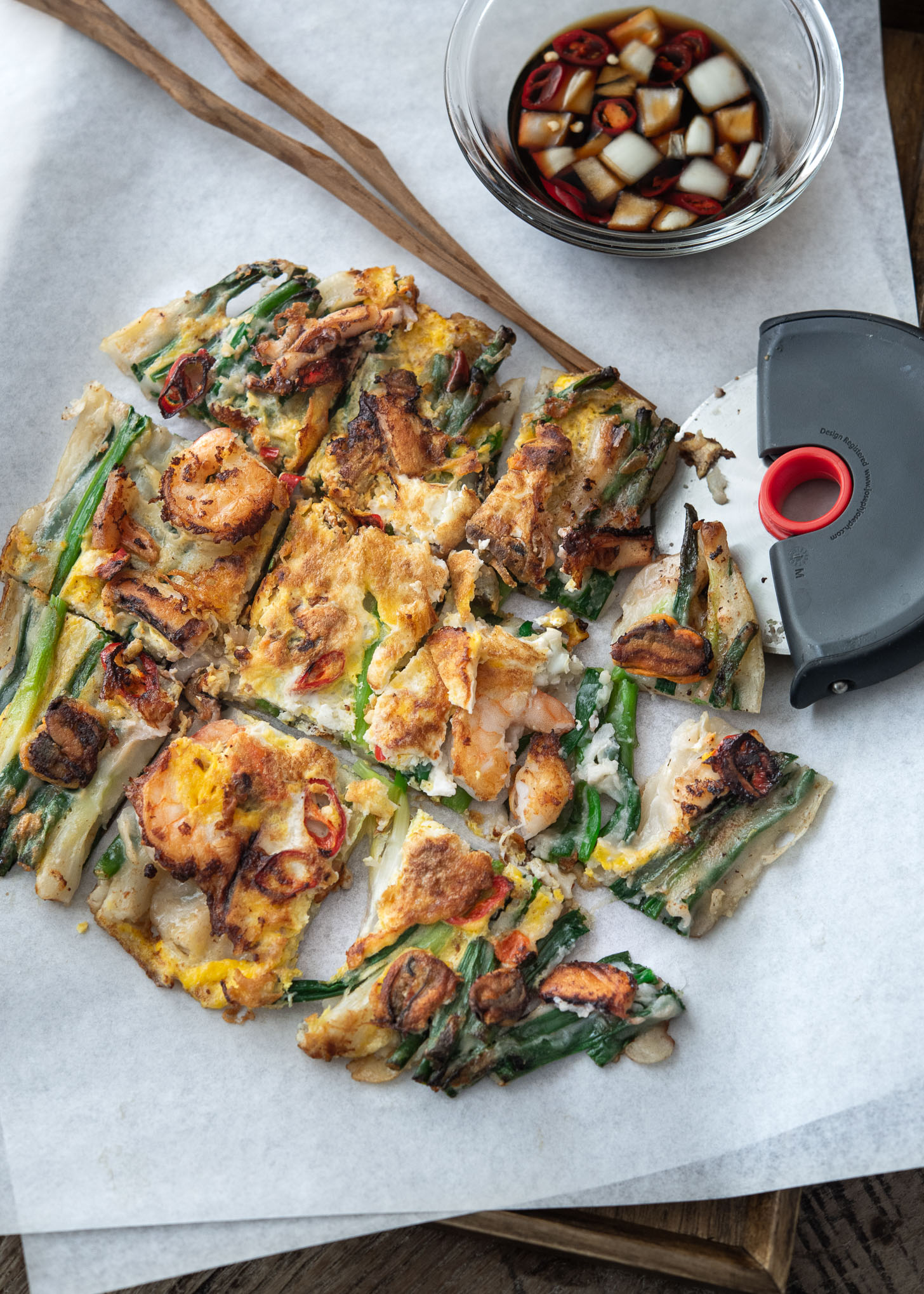
Pajeon is a popular Korean savory pancake made with scallion as its main ingredient. The word “pa” translates to scallion, while “jeon” refers to a variety of pan-fried, battered dishes.
Among the many variations, the seafood (haemul) version stands out, leading to its specific name, haemul pajeon (해물파전).
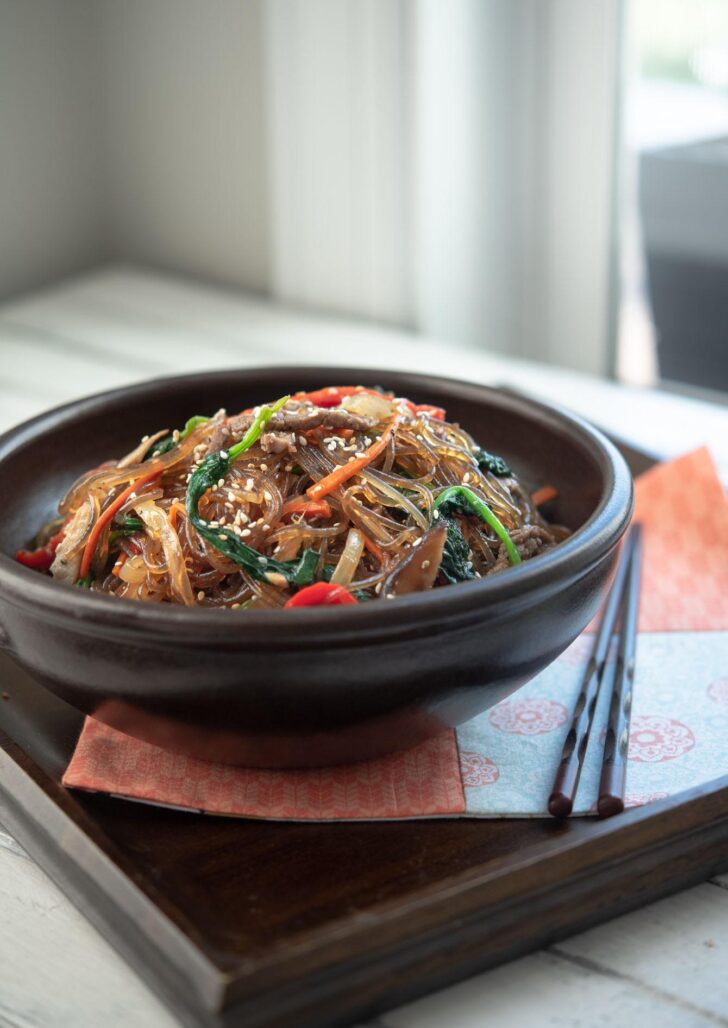
Get new recipes via email:
You just mix the scallions with a simple batter, spread it thin in a pan with some oil, and cook it until it’s golden and crispy. It’s really tasty with its inviting aroma spreading around.
Just thinking about haemul pajeon is enough to make your mouth water.
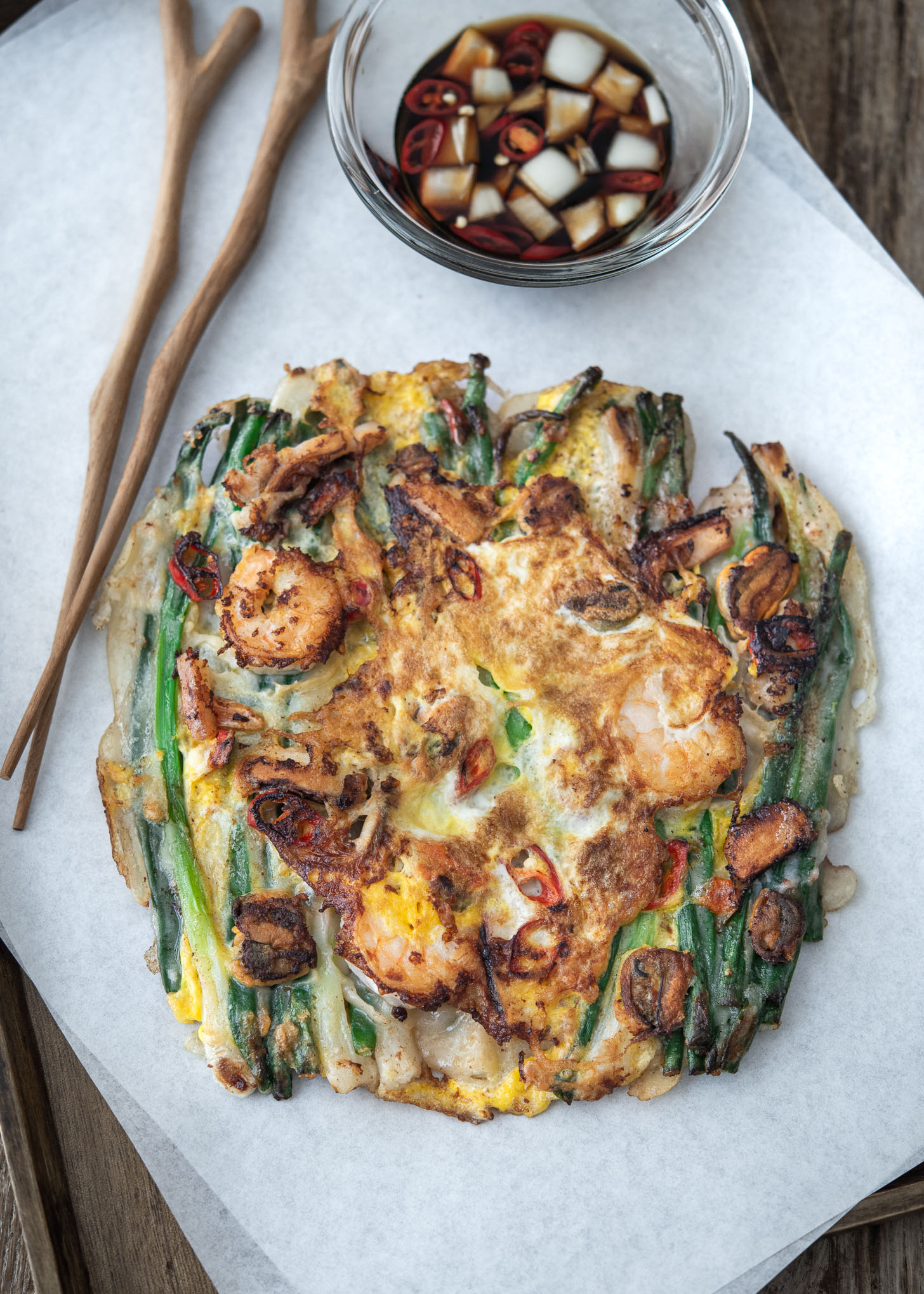
Jeon (Korean pancakes)
Korean cuisine offers a wide range of tasty appetizers and snacks. One of the must-try types is Jeon (전) or Buchimgae (부침개), which translates to pancakes.
The Haemul Pajeon recipe is among the most sought-after. Beyond seafood, there’s a whole world of vegetable-based jeon to explore, from spinach pancake to potato pancake. For more pancake ideas, check out my collection of Korean pancake recipes.
It’s easy to mix up Korean scallion pancakes with Chinese scallion pancakes. The Chinese version is crispy and layered, almost like flatbread, and filled with green onions. On the other hand, Korean scallion pancakes, known as pajeon, are thicker and softer with crispy edges. They often contain seafood and are made from a batter.
Korean Nostalgic Food: On rainy days in Korea, there’s a fun tale about a mischievous frog that many remember. As kids, we’d enjoy our Pajeon, with its sizzle sounding like raindrops, while listening to this story. So, for many, the sound of rain, a warm Pajeon, and the frog tale are deeply connected in our memories.
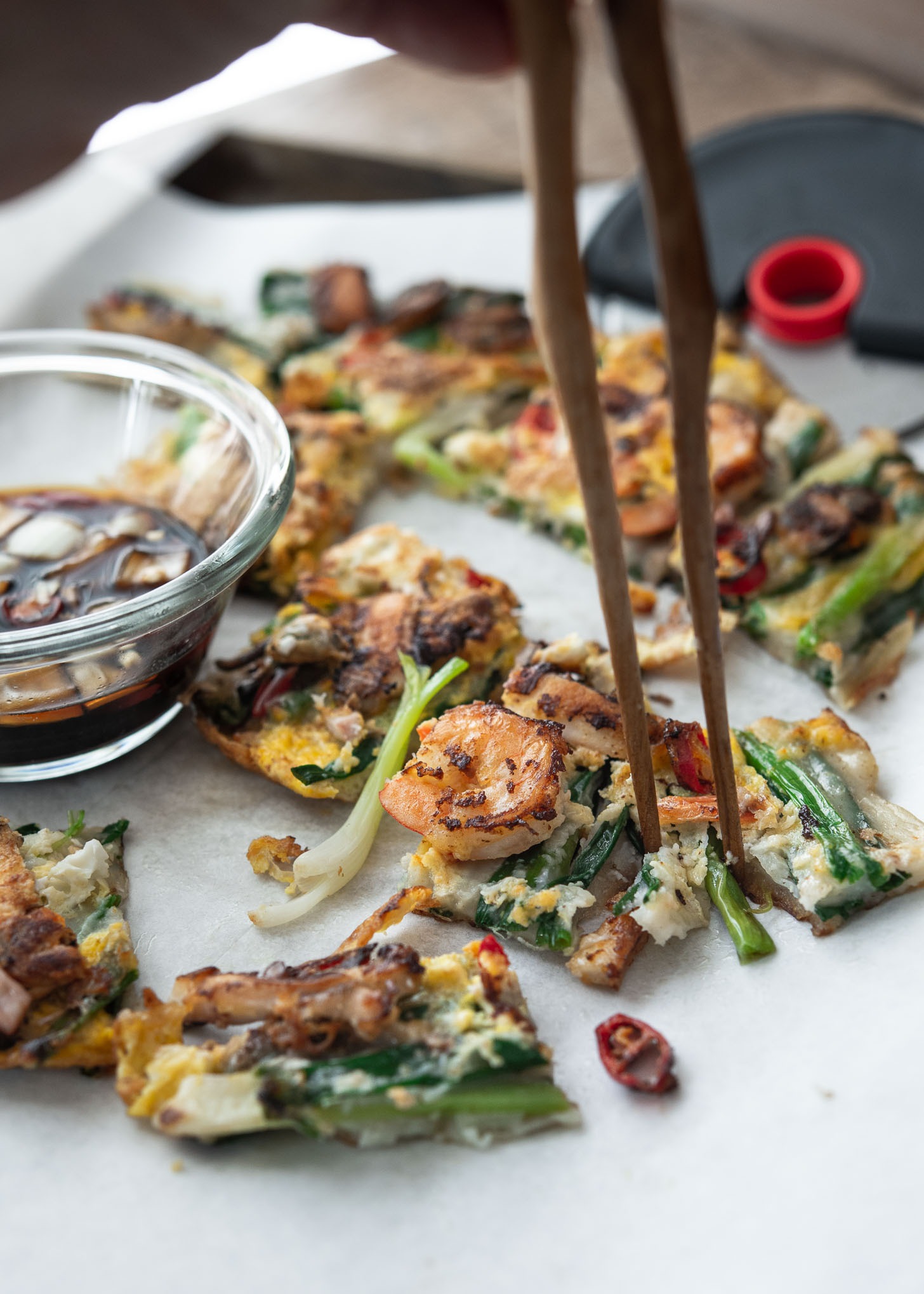
Making Korean Pancake Batter
For savory Korean pancakes, we use a simple batter made mostly from flour and water.
Many people buy a ready-made pancake mix, known in Korea as buchim garu (부침가루), which is a common item in their kitchens. This mix, which is already seasoned, usually has wheat flour, corn starch, rice flour, and sometimes baking powder to help it rise.
Sometimes, to get a crunchier texture, people mix this pancake mix with a frying mix called twuigim garu (튀김가루), which has more rice flour and baking powder. But mixing these can make the pancakes not as crispy as expected and a bit too salty.
In my pajeon recipe, I’ll show you how to make your own Korean pancake mix that’s perfect for haemul pajeon. Plus, I’ll give you helpful tips to make your pancakes extra crispy.
My Best Tips for Extra Crispy Pajeon
Batter Basics
The heart of the Korean pancake lies in its batter. While many resort to ready-made Korean pancake mix (buchimgaru, 부침가루), it can sometimes lead to a flavor imbalance. If you’re aiming for an ideal sodium level, especially when serving with dipping sauce, go homemade!
With just four staples – plain flour, cornstarch, fish sauce, and carbonated water – you can churn out a Pajeon that’s the right blend of crispy and flavorful.
Why Carbonated Water?
Carbonated water lends the batter a light, crispy touch. The carbon dioxide in it forms minuscule bubbles in the batter, offering an airy texture while ensuring an even coating on the food.
Oil Is Essential
A generous amount of oil is the secret to that desired crispy texture. While it’s not deep-frying, ensure the pan has ample oil. As you pour the batter, ensure the edges get their share of oil too.
Choosing Scallions
Pick slimmer Scallions as they are more tender. If you’re a scallion enthusiast, my Pa Kimchi (Korean green onion kimchi) recipe is worth checking out.
Fresh Seafood For Authenticity
While you can opt for frozen seafood, nothing beats the taste of fresh ingredients. However, if seafood isn’t your thing, can always omit it.
Temperature
The cooking temperature for Korean pancake can vary based on the type of heat source and pan used. It’s important to adjust the heat level accordingly to avoid burning or having a soggy pancake due to excessive oil absorption. Finding the right balance of heat and timing is crucial for a perfect, crispy Korean pancake.
Make Dipping Sauce First
For the best experience, it’s recommended to serve pajeon immediately after frying. To avoid any delay, it’s a good idea to prepare the dipping sauce beforehand so that it’s ready to go when the pancake is done cooking.
Recipe Ingredients
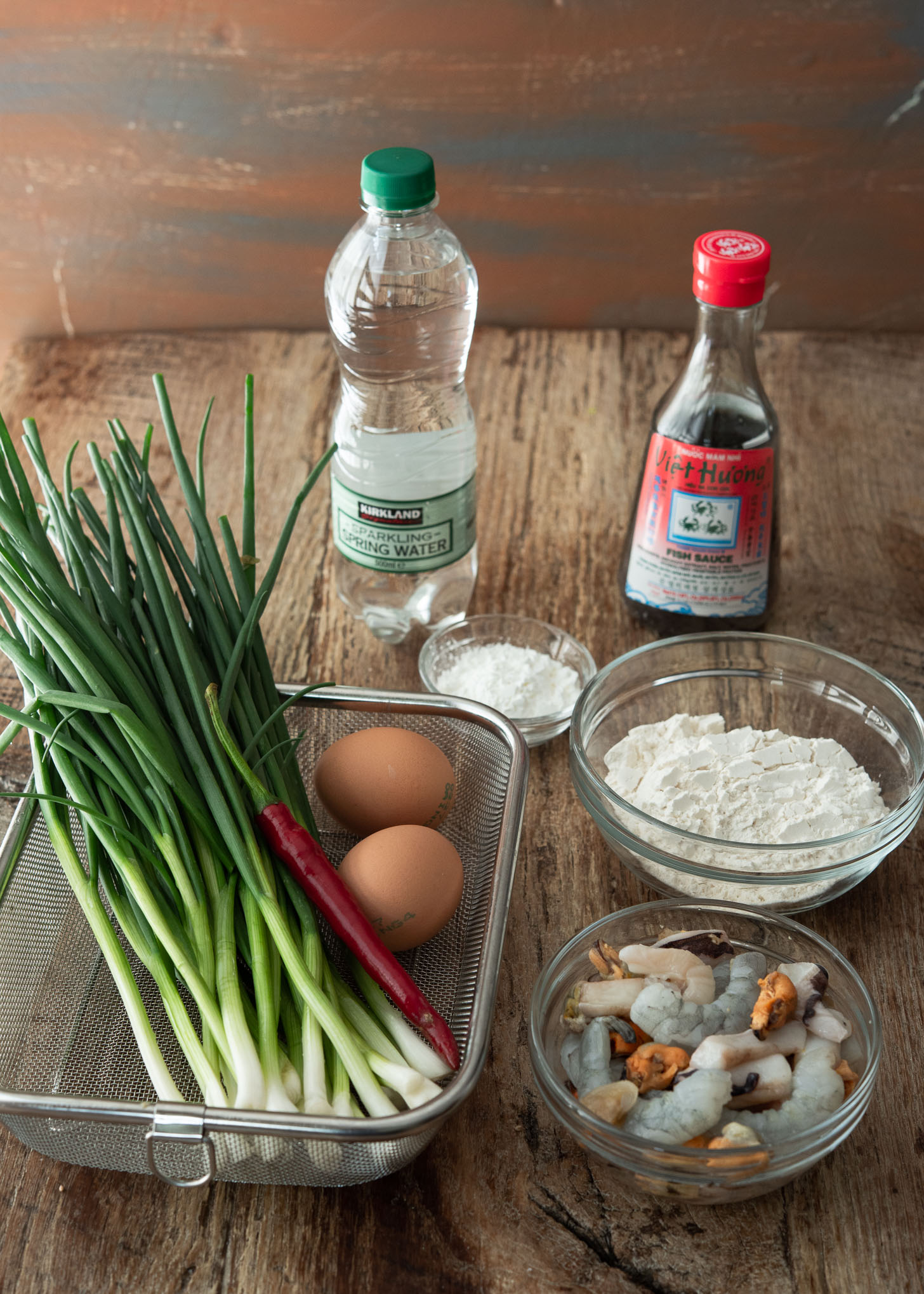
- Scallion: Choose slimmer scallions for better results.
- Seafood mix (fresh or frozen): A combination of squid, shrimp, mussels, oysters, and clams work well together. Omit seafood for plain pajeon.
- Egg: Required for binding the seafood to the scallions.
- Fresh red chili: Add for extra spice.
- Oil: Use a generous amount for a crispy texture.
For Homemade batter:
- All-purpose flour: The base ingredient for the batter.
- Cornstarch: Helps to create a light and crispy texture.
- Fish sauce: Adds a layer of flavor and brings out the umami taste in the batter.
- Carbonated water (or sparkling water): Creates tiny bubbles in the batter for a light and airy texture.
Dipping sauce:
- Soy sauce: Provides a savory and salty flavor.
- Rice wine vinegar or white vinegar: Adds acidity and tanginess to the sauce.
- Water: Helps to balance out the flavors.
- Onion: Adds sweetness and depth to the sauce.
- Fresh red chili (optional): Adds extra heat and flavor to the sauce.
How to make Haemul Pajeon (Seafood Scallion Pancake)
Make Dipping Sauce First
Prepare the dipping sauce by mixing all the ingredients together in a small bowl. Set aside.
Prep Scallions
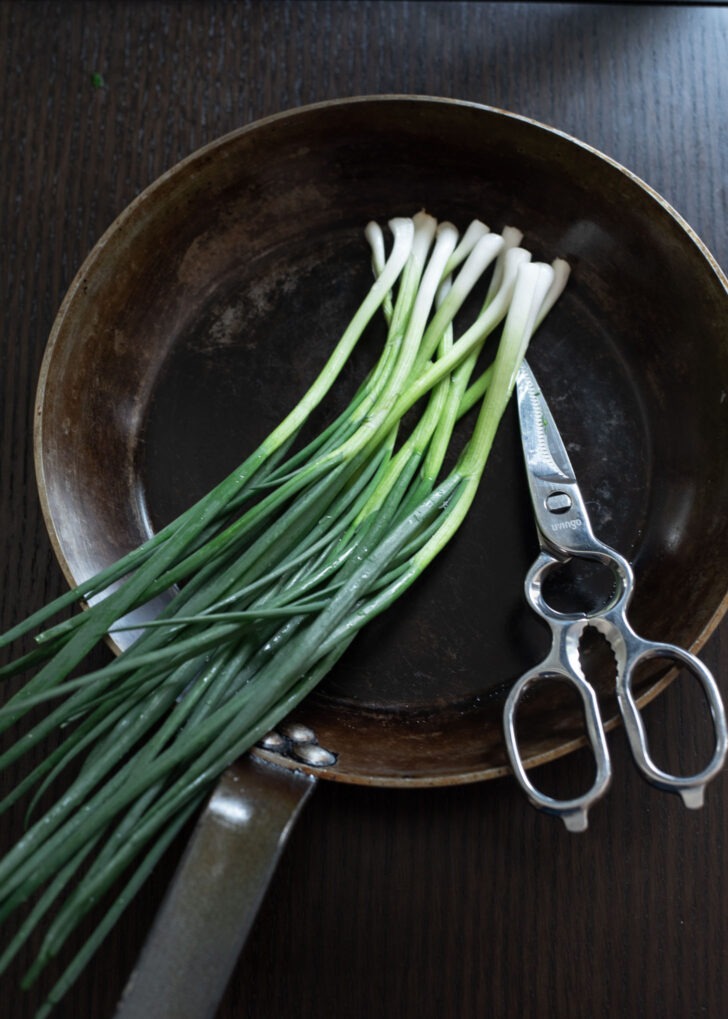
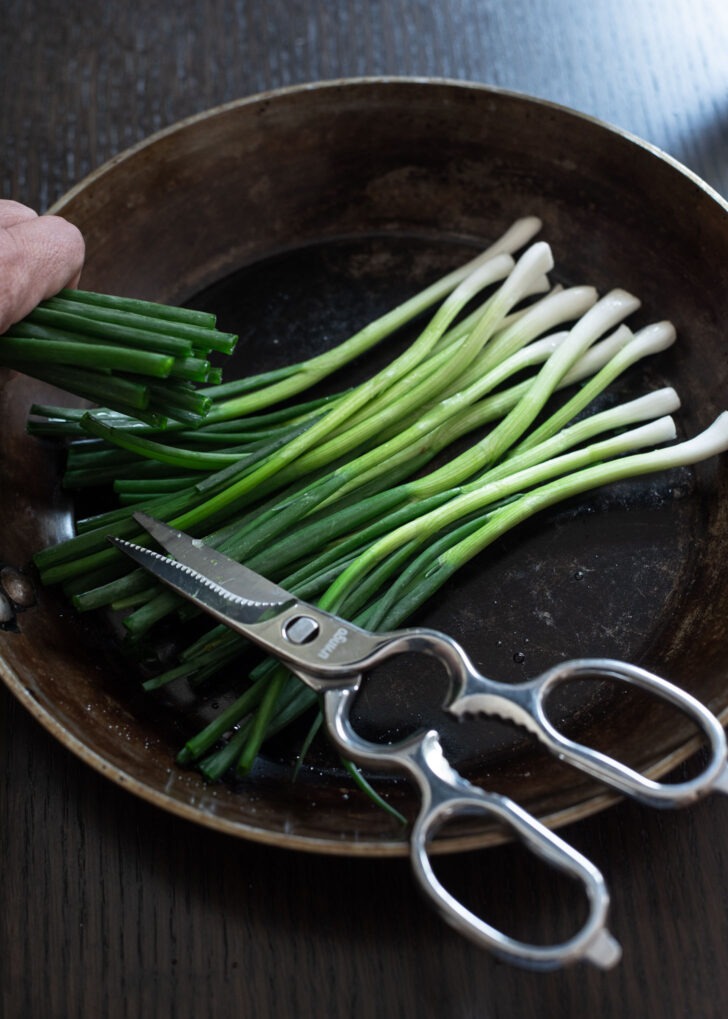
Trim the scallions to fit nicely in your skillet and set them aside. I recommend using a 10-11 inch heavy skillet for the best result.
Make Pancake Batter
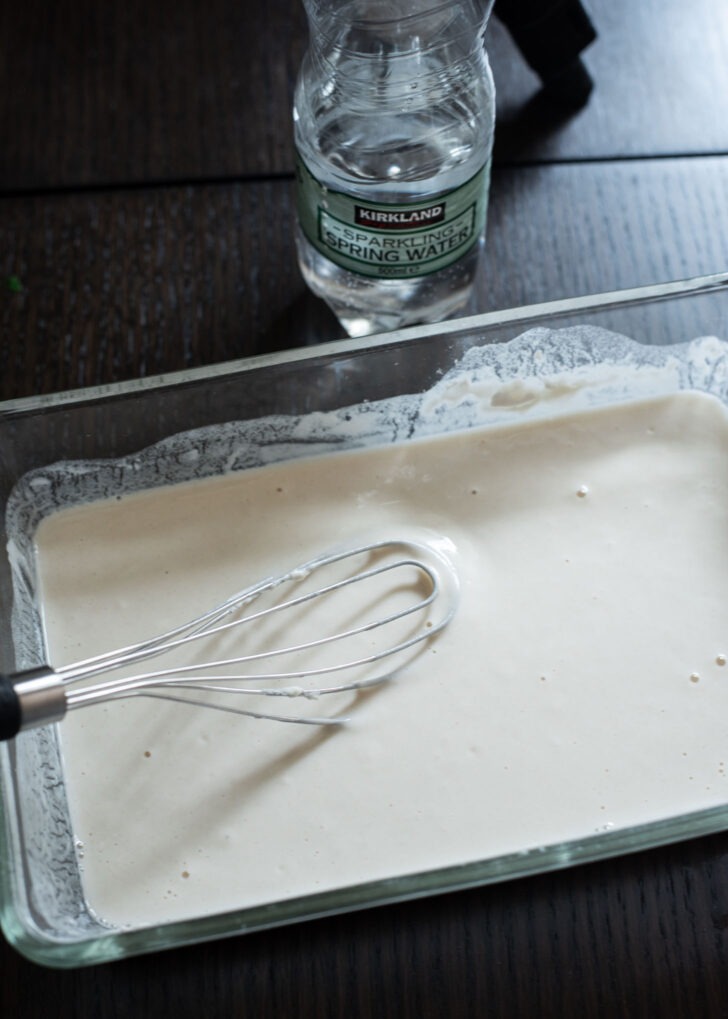
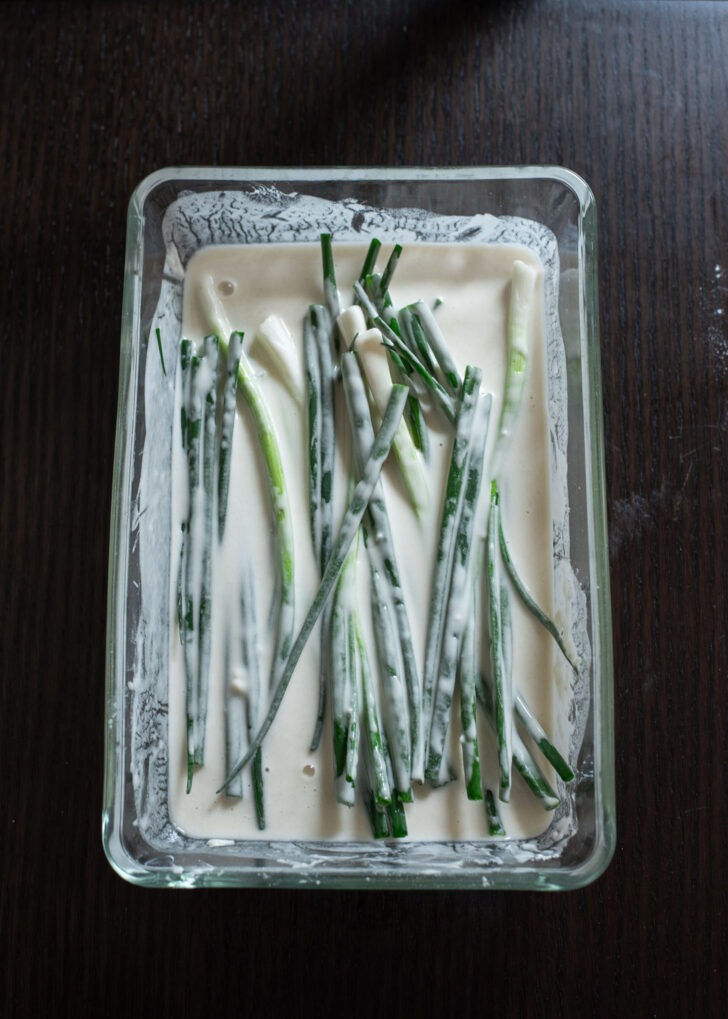
In a rectangular pan, whisk together the flour, cornstarch, and fish sauce. Pour in the carbonated water and mix until well combined. Lightly coat half of the scallions with the batter.
Combine Scallions with Pancake Batter
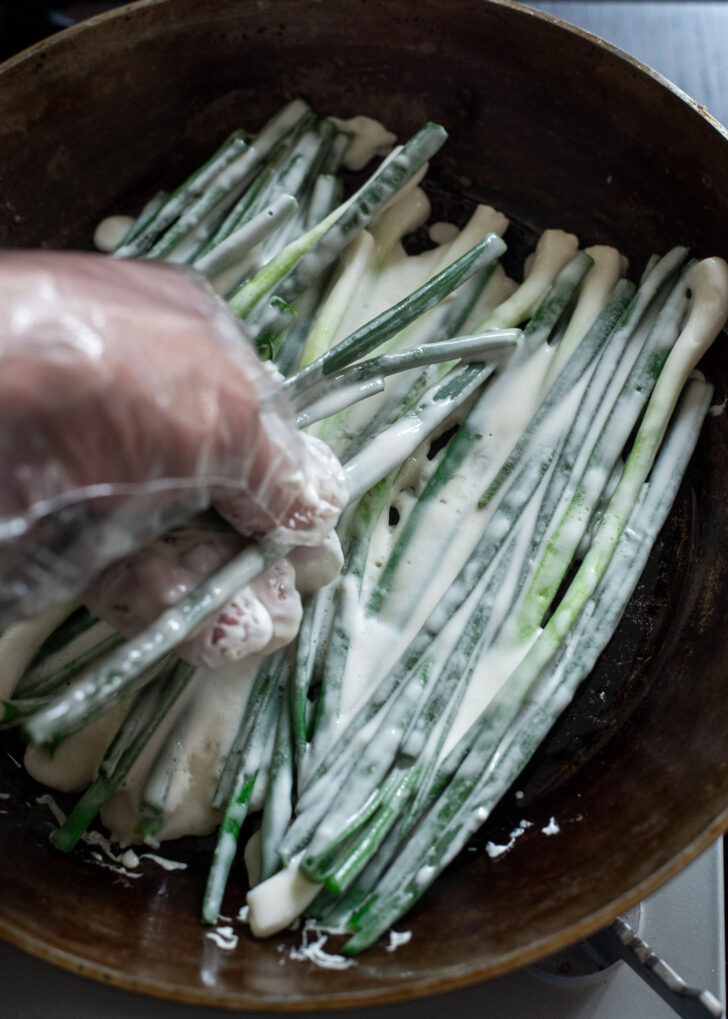
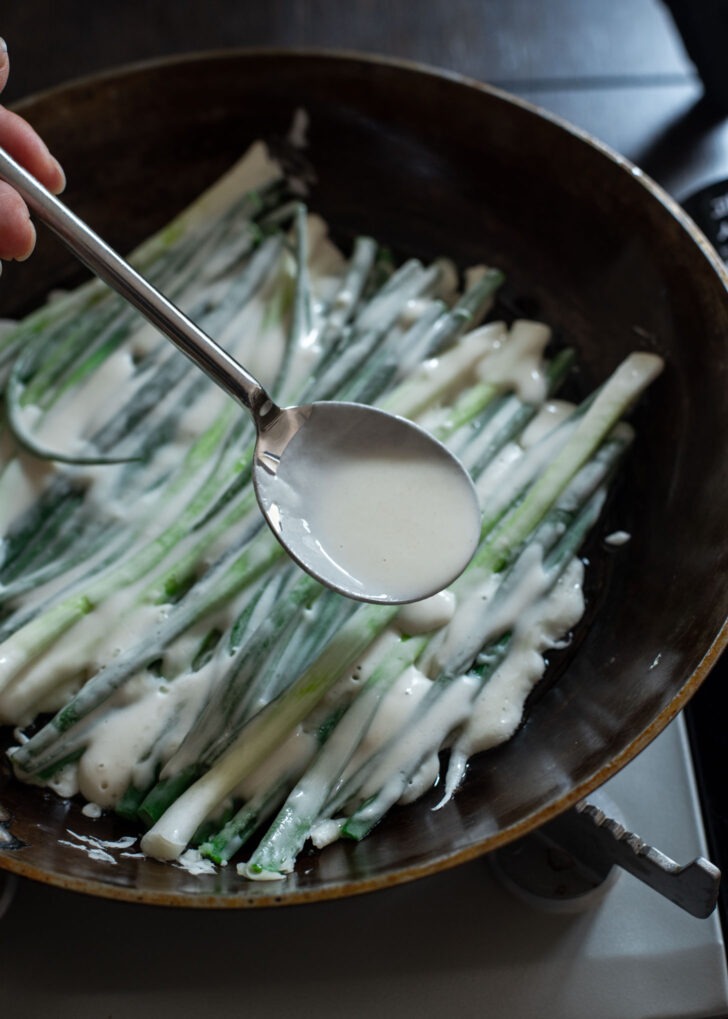
Heat 2 tablespoons of oil in a skillet over medium heat. Place the battered scallions evenly on the hot skillet without overlapping.
Spoon a small amount of batter to fill any gaps between the scallions. Avoid making the pancake too thick. Let it cook for 1 minute.
Cook Scallion Pancakes
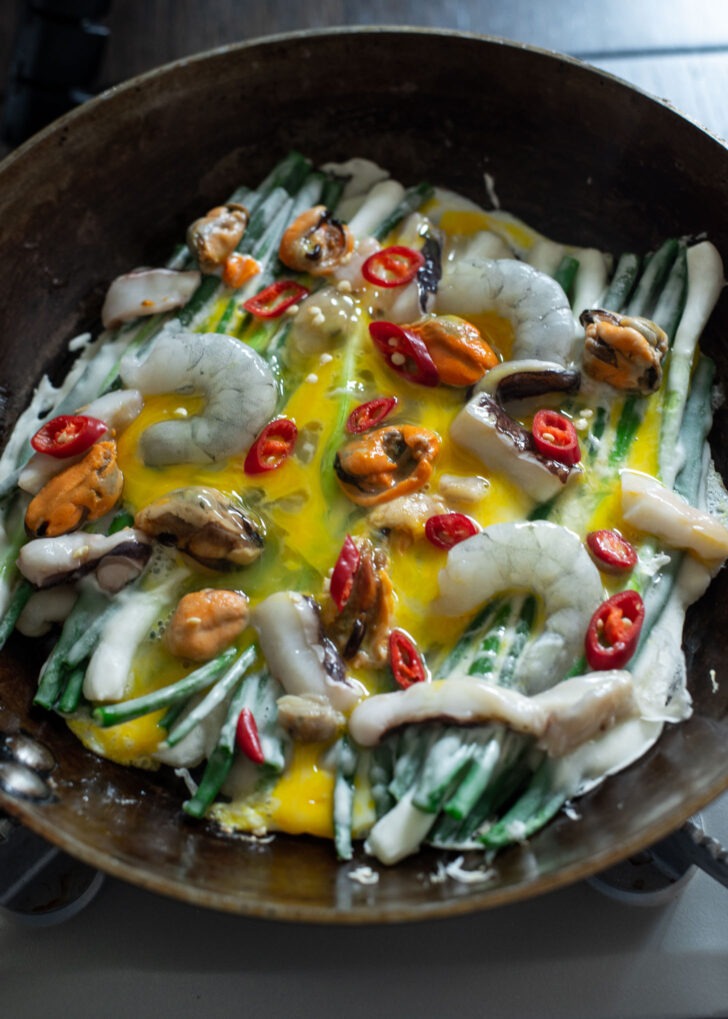
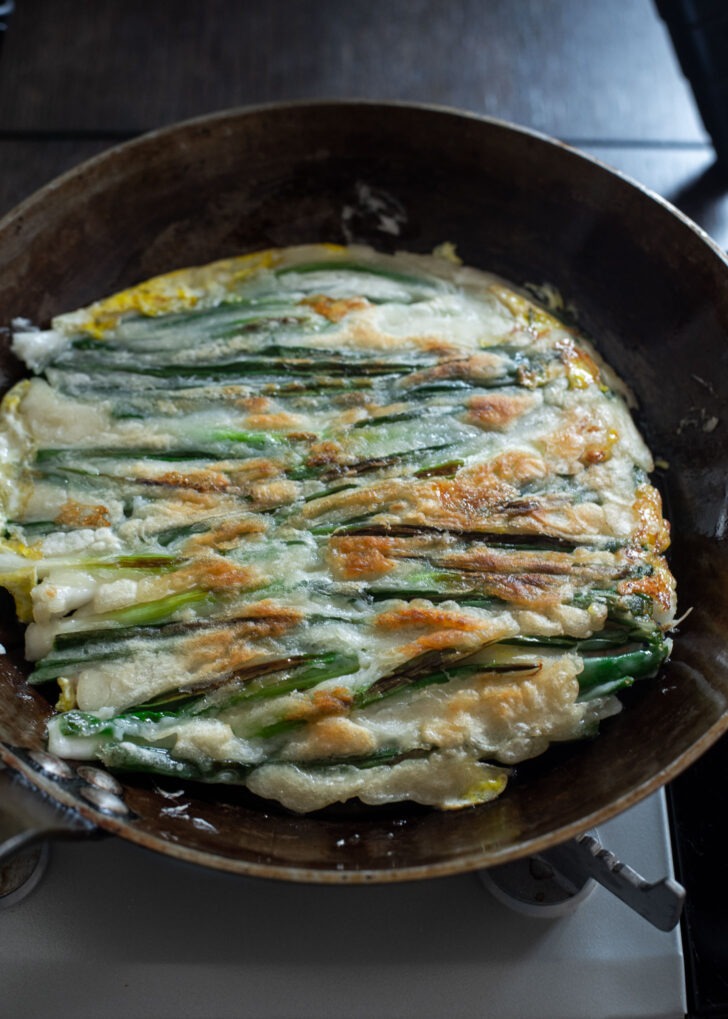
Arrange seafood (if using):
Sprinkle half of the seafood mix evenly over the scallion pancake. Drizzle a beaten egg over the seafood and dot with fresh red chili evenly.
Fry the pancake:
Let the pancake sear on the bottom until it becomes golden brown and crispy when you lift up the edge with a spatula, about 2-3 minutes. Adjust the heat so that it doesn’t burn the bottom of pancake.
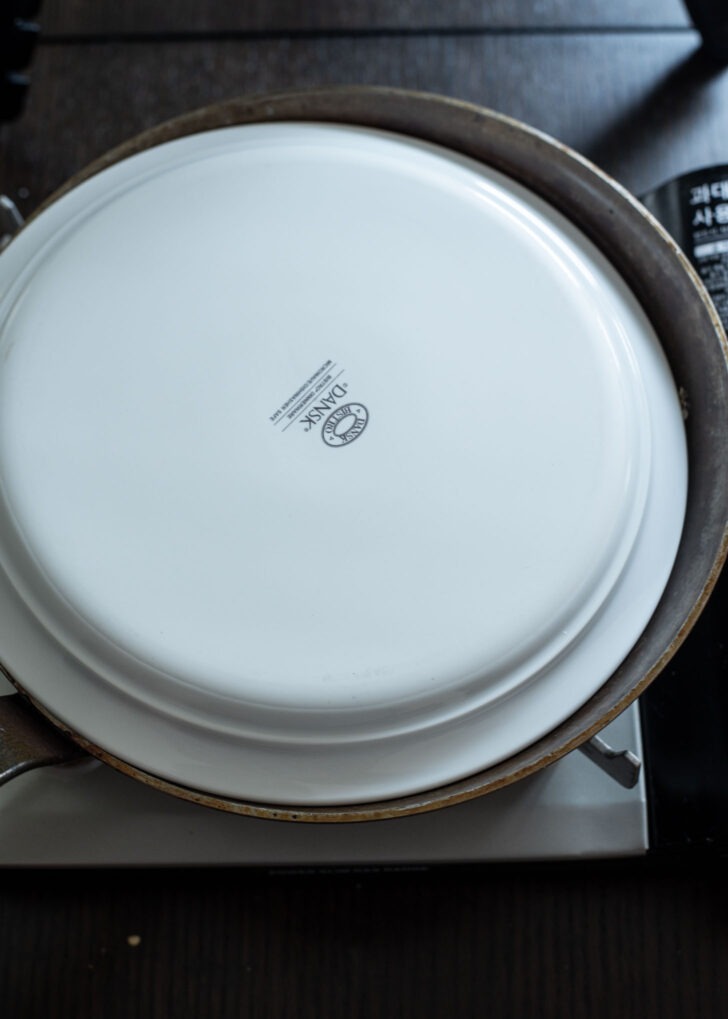
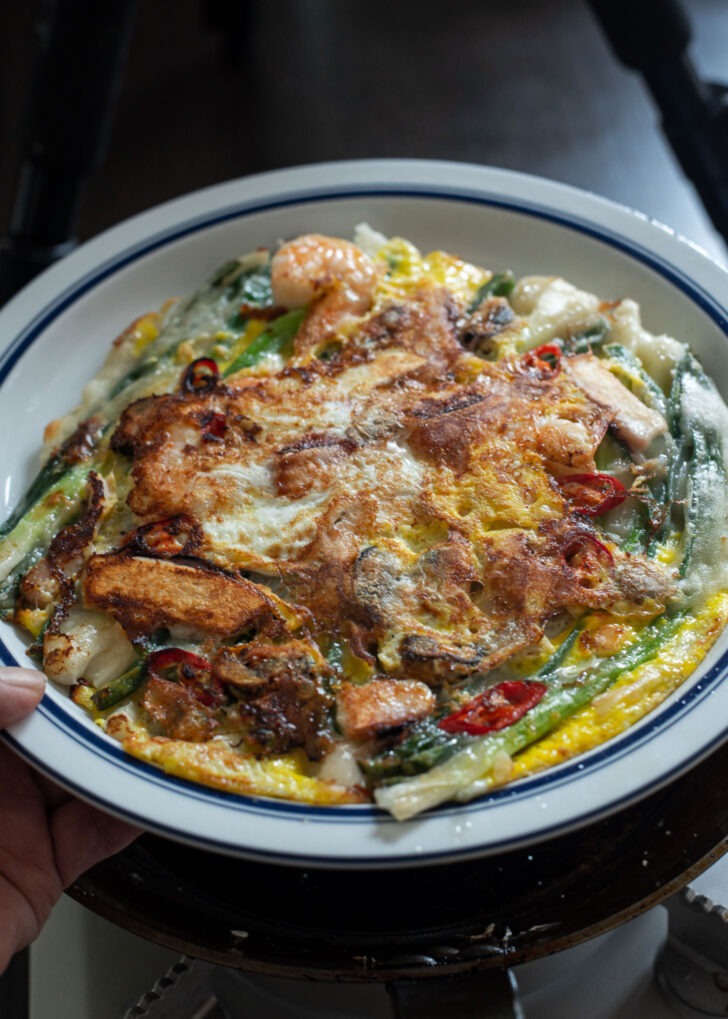
Flip to remove:
Using a large spatula (or two if needed), carefully turn the pancake to the other side. Watch out for any oil splashes. Drizzle more oil around the edges of the pancake. Reduce the heat level if the pajeon seems to darken too fast.
To remove the pancake from the skillet, you can either use a large dish or a spatula.
- For the first method, place the top side of a dish facing toward the pancake in the skillet, then turn the skillet over to reveal the right side of the pancake. Slide the pancake onto a cutting board and cut it into serving-size pieces.
- For the second method, remove the pancake carefully with a spatula and place it directly on a cutting board. Slice it into desired sizes.
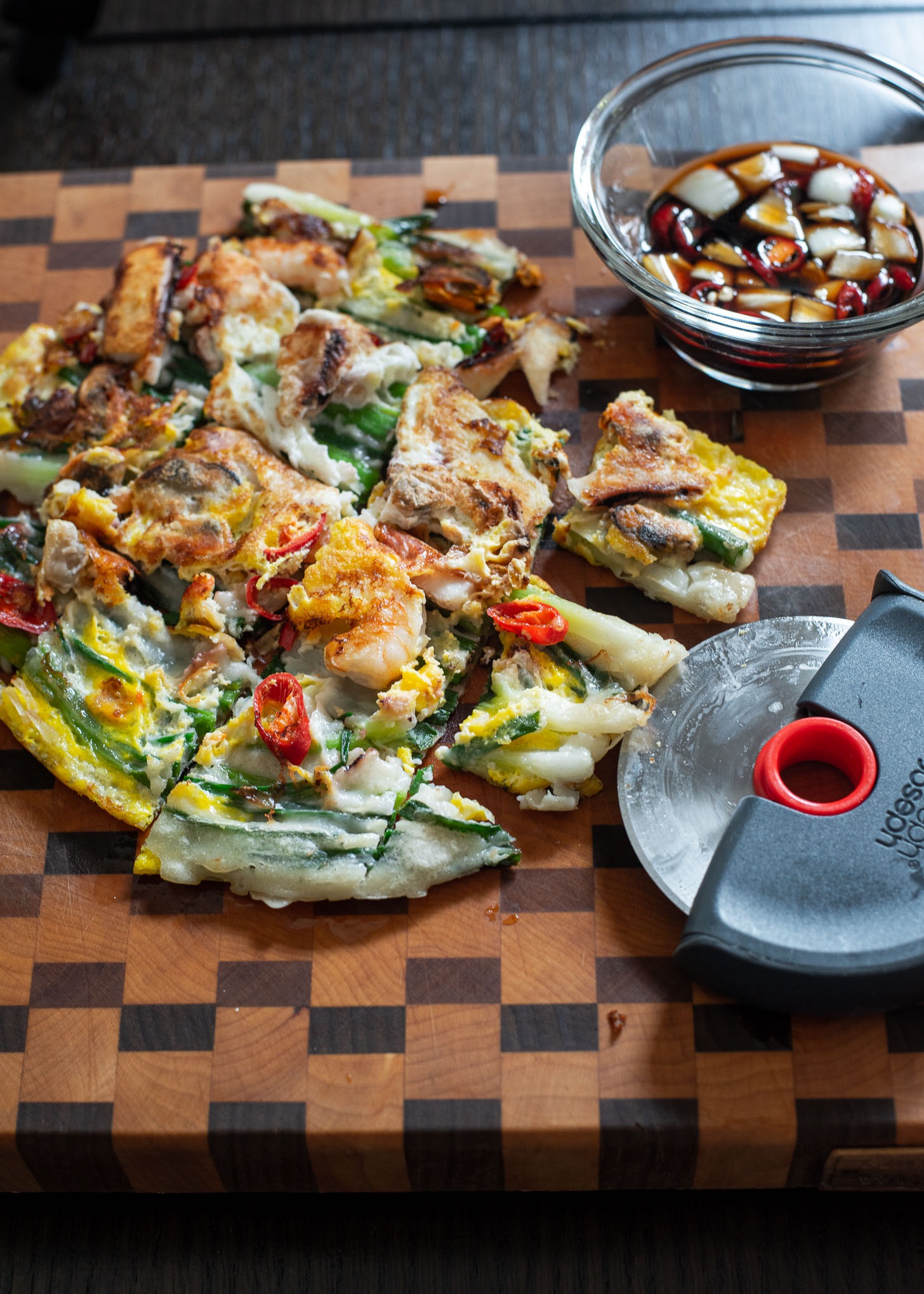
What to Eat with Pajeon
For the best experience, it’s recommended to serve the pajeon immediately after frying, so you can enjoy the irresistible combination of savory flavor and crispy texture with every bite. Be sure to serve it alongside the pajeon dipping sauce to enhance the overall taste.
I recommend enjoying it with a glass of makgeolli, Korean rice wine, especially on a rainy day. This combination is popular in Korea, and it’s definitely worth trying.
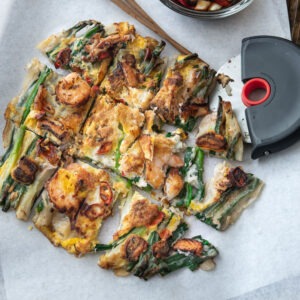
Extra Crispy Haemul Pajeon (Seafood Scallion Pancake)
Recipe Video
Ingredients
Pajeon Dipping sauce
- 2 tbsp soy sauce
- 1 tbsp rice vinegar, or white vinegar
- 1 tbsp water
- 2 tbsp chopped onion
- 1 tbsp chopped red chili, optional
Scallion Pancake
- 2 bunches scallions
- 1 cup (120 g) all-purpose flour
- 2 tbsp cornstarch
- 1 cup (240 ml) carbonated water, chilled
- 1 tsp fish sauce
- 5 tbsp oil, divided, and use more as needed
- 1 1/2 cup (360 ml) mixed seafood (shrimp, squid, and mussel), fresh or frozen (thaw first if frozen)
- 2 eggs, slightly beaten
- 2 fresh red chili, sliced, optional
Equipment
- 10-inch carbon steel pan or cast iron skillet
Instructions
Make Pajeon dipping sauce
- To make dipping sauce, prepare the dipping sauce by mixing all the ingredients together in a bowl. Set aside.
To make Pajeon
- Trim the scallions to fit nicely in your skillet and set them aside. I recommend using a 10-11 inch heavy skillet for the best result.
- In a rectangular pan, whisk together the flour, cornstarch, and fish sauce. Pour in the carbonated water and mix until well combined.
- Heat 2 tablespoons of oil in a skillet over medium heat. Lightly coat half of the scallions with the batter and place them evenly on the hot skillet without overlapping. Spoon a small amount of batter to fill any gaps between the scallions. Avoid making the pancake too thick. Let it cook for 1 minute.
- Sprinkle half of the seafood mix evenly over the scallion pancake. Drizzle a half of beaten egg over the seafood and dot with some fresh red chili evenly. Let the pancake sear on the bottom until it becomes golden brown and crispy when you lift up the edge with a spatula, about 2-3 minutes. Adjust the heat so that the bottom of pancake doesn't burn.
- Using a large spatula (or two if needed), carefully turn the pancake to the other side. Watch out for any oil splashes. Drizzle more oil around the edges of the pancake. Adjust the heat level if needed.
- Remove the pancake from the skillet, you can either use a large dish or a spatula. Repeat the process to make the next batch of pajeon.
- Serve the pajeon immediately after frying. Cut it into serving-size pieces and serve it alongside the pajeon dipping sauce.

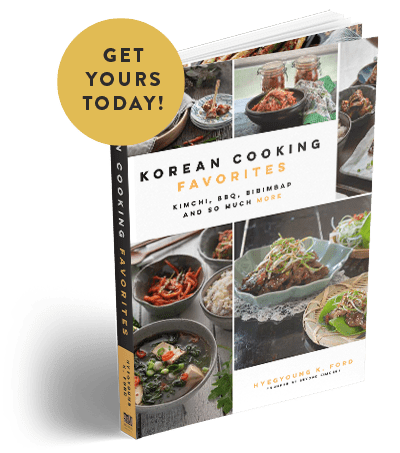
Any chance this can be made with GF flour please?
GF flour will work fine. I hope you enjoy this recipe. Thanks!
Thanks Holly!
The story is about a GREEN frog, not a blue frog. In korean “chung” can mean both, but the folk tale is about a green frog who disobeyed his mother. (http://www.sejongsociety.org/korean_theme/korean_folk_tales/green_frog.html)
Thanks for the clarification, Jack. I guess green frog makes better sense than blue frog.
I’ve read other recipes for green onion pancakes and this is the first one that has more than green onion in it. I know my family would love to eat this one esp. because of the addition of the shrimp. I like the look of the red chili in the pancake, but wondered about the heat level. Is there a kind of red chili that has moderate heat that you can recommend? I guess we can eat around it, huh. Thank you for sharing your recipes and I hope you’re feeling better! ^-^
Hi Sachi, I used chili called lady finger chilies (very common Asian chilies). If you remove the seeds and the membrane, they are not that spicy at all.
Love your stories, love your blog! I’ve been talking about “Holly” to everyone…. you made cooking Korean dishes so easy and manageable. I like to add zucchini and mushrooms to my Pa-Jun. So delicious!
Thanks Adela. You are so sweet.
hi holly! thank you for sharing this. it looks delicious and i’m eager to try this at home tonight!
This brought a smile to my face! I am half Korean, and my mom told me and my brother this story repeatedly as we were growing up! I used to tire of hearing it but I now find myself telling the same story to my own kids! I .make a version of this pancake with thinly sliced and diced zucchini, onions and green onions. YUM!
thanks for sharing this lovely receipe
Where are your turquoise chopsticks from???
Love love love this blog!
what lovely writing and beautiful photographs. yesterday i tried making pajeon for the first time ever as it has been raining in london for days. they were good and got gobbled up by my friends in seconds, but i think not crispy enough, i will try with your recipe next time x
Hi Tom, I think pajeon will taste better in London than anywhere else 🙂
To make crispier texture, the type of flour is one thing but also the right type of skillet you use and the temperature control is another. I use carbon steel skillet which I think it helps to create crisp texture outside. Also be generous with amount of oil you use to fry. Searing the outside crust to deep golden is the key.
thank you holly, they worked even better this time, i think using a little less egg helped the crispiness as well. i’m now looking forward to more rainy days!
Thanks Tom. You have mastered the techniques of making the crisp Korean pancakes! Way to go!
Those look gorgeous. And delicious. I am saving this recipe now! And I will be browsing your website to see what else to cook with it, this is a new cuisine for me!
I made these tonight (coincidentally it’s raining), they were so good! Thanks for this recipe!
Great! I am glad that you liked it.
I tried Korean pancake with all purpose flour and rice flour, loved it. I will try your version too. You have a nice blog. Sure I will come back for more Korean recipes.
Hi Mabel
Yes, you can add the rice flour if you like the chewy texture. I tried and I prefer without it in the savory pancakes. I just love the crispness that cake flour adds.
Thanks for you sweet comment. Blogging is fun and wish you the best with your brand new blog.
I've tried making pajeon using just all purpose flour but didn't think it tasted as good as the packet flour. I haven't tried it with cake flour though… But I think adding sweet rice flour would give the pajeon some sticky, chewy (jjinduk) texture.
I love your blog a lot! I've started a blog myself and you're a huge inspiration.
Thanks
Mabel
mdcooksfor2.blogspot.com
Thanks Angel. Hope you be back again soon.
First visit. Haven't had much Korean food, but love the recipes I've read so far. Will be back to read more. Great blog!!
Really nice story. And a great pancake. Although I totally like the breakfast pancakes with maple syrup, savory pancakes are more interesting to me. A nice way to use veggies. Thanks for this.
This is my first
time I visit here. I found so many interesting stuff in your blog especially
its discussion. From the tons of comments on your articles, I guess I am not
the only one having all the enjoyment here keep up the good work.
Thank You
Hi Bo
My daughter used to love the story called, "The contrary Mary" and, to some degree, it was great for children to come up with creative ideas to be contrary I think. I never heard of the version of frog jumping into stream. That is even more sad.
What a fantastic post! Lovely story… and those pancakes look divine! And simple too. I think I'll have to try it some day 🙂
Oh I heard a version of this when I was growing up! The difference was that instead of the mother's death, she told him not to jump into the stream and that's exactly what he did, thus leading to his death. The funny thing is, my dad told me this story because I started doing what the boy frog did. It wasn't necessarily my fault at the time though, because I was joking around saying it was "opposite day". But after that day I never played "opposite day" again…
I am glad that you liked it. Thanks Renee.
I made these last night and they were easy + delicious! Thanks for the recipe and the story. I love your blog!
Ha ha, we all were the blue frog in some degree.
Lisa
Actually rice flour is to get a chewy texture not crisp. If you want crispier but doesn't have cake flour, add about 2-3 tablespoon of cornstarch to plain flour with a tiny pinch baking powder.The baking powder will leaven the batter slightly and help create the crisp texture
Thanks Holly! Sorry for the late response. You are right, when I make them with the rice flour the pancake is slightly chewy. I think I will try your cake flour suggestion!
Thank you for sharing the recipe and the story. I love green onion pancakes, and your recipe looks so simple and delicious!
yum yum yum! i love pa jun!
and i vaguely remember this story. maybe because my brother and i were like blue when we were little kids. 🙂 i think it's time to tell my kids!
love your website and photos!
Holly,
I have a recipe for scallion pancakes that calls for a little rice flour and more regular flour. The rice flour is supposed to make it crispy. I think it works but do you think I can put more rice flour in than the regular flour and still have it come out?
Thanks!,
lisa
Thanks for stopping by Nami. Hope to communicate with you often through our blogs.
This looks and sounds delicious!
~Mo
http://www.mokekumileicreations.com
I cannot believe I haven't stumbled your blog before too! Thank you for stopping by my blog. I need to look around when I blog hop. =P
Your green onion pancakes look so delicious – your photos are gorgeous and I love how you put step by step photos (large and nice) in the post too. So fun to follow you cook. Nice to meet you!
Lyndsey, this pancakes will tastes good whether it rains or shines. Hope you get to try soon.
I loved this post, thanks for sharing a little Korean tradition with us. I like your food for thought of the day! I work in an elementary school and I see first hand the children that don't listen. 🙂
I have been wanting to make a crispy Korean pancake, now you just reminded me to try it! It looks great for breakfast in my eyes. Too bad I didn't have it yesterday it rained here. 🙂
There is a small section on the navy base with kimchee(not good), and some Shin Ramen….thats about it!! I need some kimchee jigae out here and ttuk bo sam and…my favorite kimchee moomalangi. My mom has attempted to try and send some from America, still waiting to receive it!!!
you are AWESOME! i loveeeee these pancakes 😀
Yes surely, the moment i try and make it as tasty and beautiful as you did will surely be the first one to inform you.
Thanks Bloggy. Hope you can give it a try. It is quite appetizing especially on the rainy days.
You are so sweet. My daughter actually gave me a hug after she heard the story.
The story and the recipe both are too good, the monsoons will be here in a month or two and I will surely make this and eat them, while blue cries nearby.
Thank you Leah. What a beautiful place you live in. Can you find Korean groceries there?
So so amazing! Thanks for sharing this!
I remember reading that story from the korean folk books my mom got for me when i was younger. And…I love korean pancake!! so so much…my halmunee made these sooo yummy for me as a child. And now my mom. I shall make them for my little one soon!! I love your blog and all the korean food on here….makes me miss korean food so bad (i live in sicily)
Aww, what a sad story. I want to give my parents a hug and make them pancakes now!